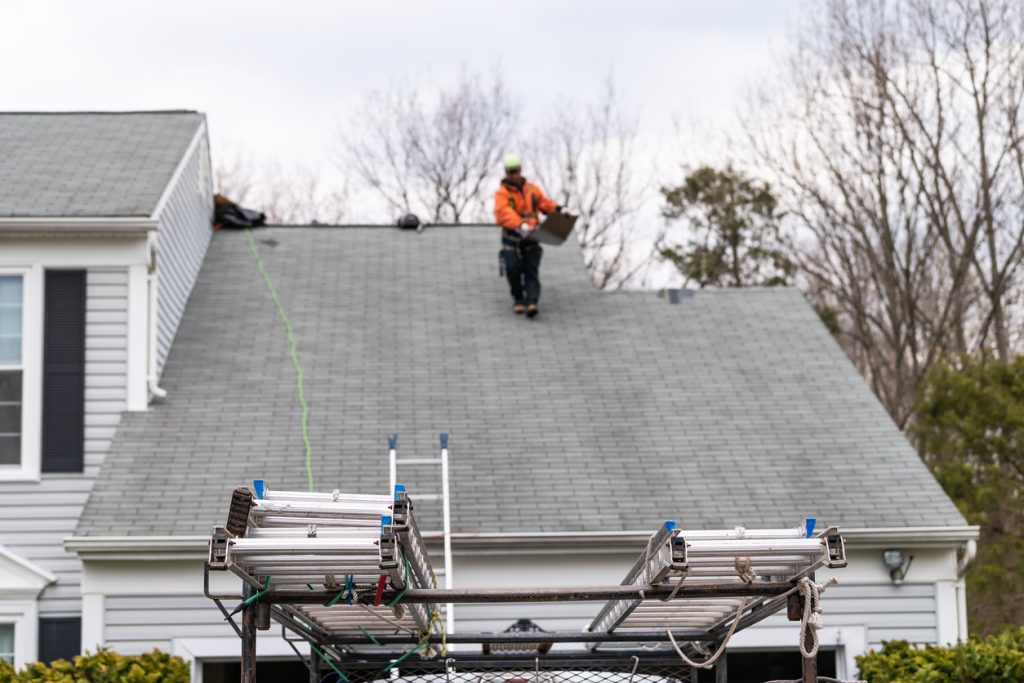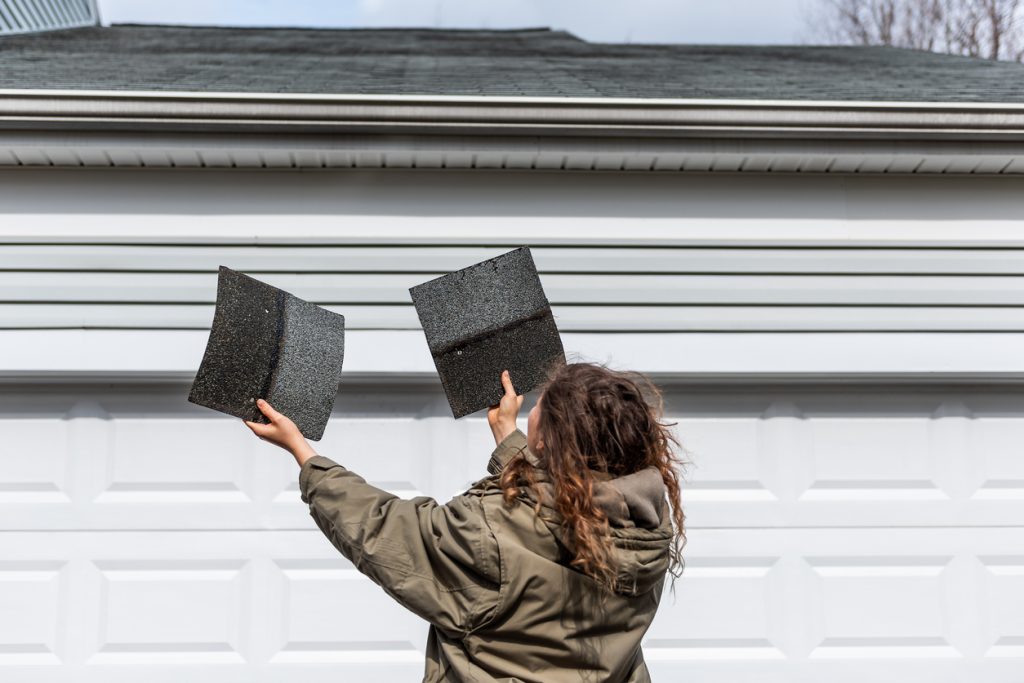Summary:
- Replacing your roof is a big decision—it’s important to know if the timing is right. Red flags like cracked shingles, leaks, and moss growth are strong indicators that your roof needs work.
- Choose your roofing contractor carefully to avoid potential quality issues. Expertise, reputation, and credentials are just as important as cost.
- DIY roofing is an option, but it can be extremely dangerous. It’s also difficult work that can lead to unexpected complications, even for professional roofers.
- Roof replacements are noisy and can disrupt daily life—schedule work wisely and let your neighbors know contractors will be on-site in advance.
- Deciding between layering shingles or fully stripping the roof depends on the damage’s extent. Ask your contractor to walk you through the options.
- If you’re not ready to replace your roof yet, Roof Maxx treatments are a cost-effective alternative for rejuvenating your aging shingles. This plant-based oil restores flexibility and helps extend the life of your roof.
Completing a new roof installation may be critical to protecting your property from the elements. Given the expense and effort involved in installing a new roof, you’ll want to be confident it’s exactly what you need before making any commitments.
By going through this list of things to consider when replacing a roof, you can make better decisions that result in a roof that looks good and works well for many years to come.
When Is It Time to Replace Your Roof?
As with every other component of your house, the roofing system was not designed to last forever. There are instances when you can fix roof damage with simple repairs, but eventually, you’ll need a complete roof replacement.
Knowing what to look for is the first step in determining if you need a new roof. If your roof is nearing or has reached the end of its lifespan, you should consider replacing it. At this point, many issues become evident. These issues may include cracked or broken shingles, leaks, damaged flashing, moss growth, and a sunken roof.
The life expectancy of an asphalt shingle roof ranges from 10 to 30 years, depending on several factors like the local climate and the surrounding environment.
Things to Consider When Replacing a Roof
Knowing what to expect during a roof replacement may save you a lot of time and money in the long run. Check out this quick guide to help you get ready for your big project.

1. Is Replacing a Roof Yourself an Option?
A do-it-yourself roof replacement may be for you if you have the necessary tools and knowledge. Just keep in mind that this work will demand a significant amount of labor, time, and attention to detail. Furthermore, you must use the appropriate tools and follow specific procedures to execute the job safely.
2. Compare Your Options for Roofing Companies

Although tempting, do not make the mistake of choosing a roofing contractor based only on pricing. While some companies offer quality work at affordable rates, unusually low rates may indicate that a contractor might be cutting corners and leaving you with subpar results.
When selecting a contractor to replace a roof, it’s critical to consider their reputation, expertise, and credentials.
3. There Will Be Noise
New roof installations can take several days to complete. During this time, the scraping, stripping, and hammering of shingles will produce a lot of loud noise. Therefore, one of the many things to consider when replacing a roof is choosing a schedule when the noise will be least inconvenient. You can also notify your neighbors about the project ahead of time to be considerate. Additionally, you may want to temporarily let your family or pets stay somewhere else if they are sensitive to loud sounds.
4. Layering vs. Stripping
If your home has suffered considerable damage from rain, ice, or hail, stripping the roof, which entails completely removing it, may be the best restoration option. However, depending on the extent of the damage, your roofer may advise layering rather than stripping. This includes putting new shingles on top of an existing shingle layer. During the estimate, make sure to inquire if your contractor will remove the existing roof.
You may also be concerned about the gutter system. Do gutters have to be removed when replacing a roof? It’s generally best to do so if you don’t want them to be damaged in the process.
5. Examine Your Roof Framing
To help your roof last longer, take advantage of a roof replacement to check for leaks and do any necessary repairs. The roof framing supports your roofing material and prevents water from entering your home. It’s also routine for roofers to examine the flashing or framing on the vents so they can determine if any rust or rot requires vent replacement.
6. Review the Contract Carefully

It’s crucial to have a written contract in any home improvement project to avoid miscommunication between you and your contractor. Make sure your contract includes materials, quality of service, total cost, schedule, and other details you’ve specified with the roofer. Also, don’t sign on the dotted line unless you address all issues and fully understand everything on the contract.
7. Acquire Other Essential Documents
Before getting started, see if you have the right documents, such as permits your city or county requires. You will need a building permit, similar to one required for any major work done on your home. Since full roof replacement is considered a structural project, pulling the right permits is among the things to consider when replacing a roof. Remember that requirements vary for every location, so check what applies to your situation.
You can avoid delays and other inconveniences by having the proper paperwork and documentation. What’s more, they help ensure the roofing job’s legality and quality.
Is It Better to Replace a Roof by Yourself or Hire It Out?
Some homeowners consider re-roofing their homes themselves to save money. A DIY roof replacement may only set you back half of the total project costs by a professional roofer. If a contractor estimates $10,000 for the full replacement, you may spend less if you buy the materials and work on the roof yourself.
That said, you should account for risks and unexpected complications that come with the job, including:
- Falling off the roof
- Discovering a damaged or weakened deck
- Not getting your materials because of delivery delays
- Purchasing the incorrect products or insufficient quantities
- Installing the shingles wrong
- Correcting mistakes, costing you time and money
While it’s possible to do the project yourself, it’s better left to professionals. It is more cost-effective in the long run and a safer option for you. Roofing contractors have the knowledge, expertise, and equipment to get the job done faster and more efficiently than you.
You Might Not Need to Replace Your Roof Yet
Indeed, there are many things to consider when replacing a roof. Fortunately, you may be able to hold off on replacement for now and rejuvenate your roof instead. With the help of Roof Maxx, you can revive your old roof and extend its life.
We understand that time and cost are two of the most important things to consider when replacing a roof, which is why we’ve developed a treatment for aging asphalt roofs. Roof Maxx is a quick, affordable alternative to roof replacements. Our soy fusion technology covers asphalt shingles in natural plant-based bio-oil to restore what they’ve lost over time that made them dry, brittle, and weakened.
One application improves your roof’s condition, allowing it to withstand weather fluctuations and extreme temperatures like a newly installed roof would. Contact us today to learn more!





